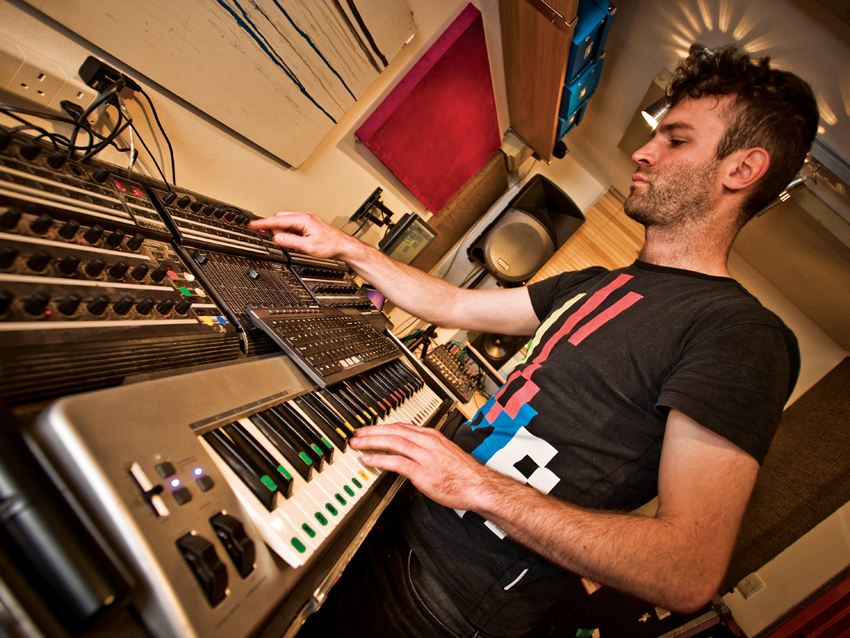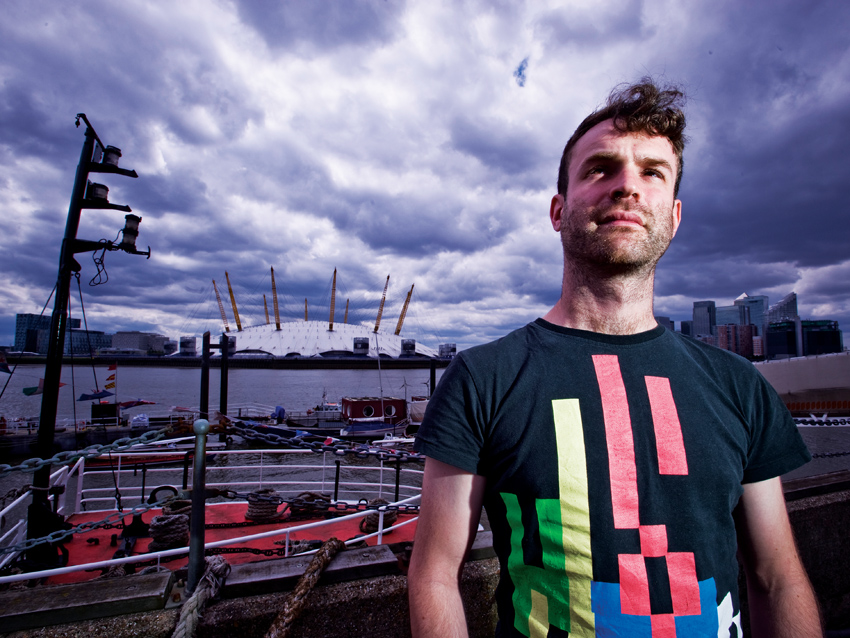Tim Exile on creative sampling

Few people take the concept of live sample mangling and resampling as far as Tim Exile. Always the experimentalist, Tim's love of chaotic live performance has seen him release half a dozen EPs and albums on Warp, Moving Shadow and Planet Mu, and he is the creator of Native Instruments' The Finger.
His style ranges from wild experimental to glitchcore, and from DnB to sonic sculptures that defy all classification. It's this unpredictability that's allowed him to collaborate with other arch-experimentalists, including Imogen Heap, who Tim remixed live, and Jamie Lidell, who he covered for a workout that made its way onto the Warp20 compilation.
Tim may use Pro Tools in the studio, but his live setup is based completely around a Reaktor machine that's wired into a hefty flight case packed full of MIDI controllers. These allow for precise manipulation, so he can add anything from basic looping and delays to full-on, multilayered FX patches that destroy (to varying degrees) whatever happens to be passed through their algorithmic corridors.
Tim's been honing this powerful setup for a few years now, so when he fires up the system to demonstrate the supreme hands-on sound-mashing potential contained within, it's not more than about a minute or two before drum rhythms, vocal loops, glitches, timestretches and pitchshifting wildness are combining to create a barrage of jarring sounds that are constantly evolving as he samples and resamples on the fly.
Given that sampling and resampling make up the backbone of Tim's work, we thought we'd find out what inspires this real-time sonic manipulator…
What does sampling mean to you?
"It means grabbing a sound; grabbing a moment. My first sampler was an Akai S-1000, and that was much more about sound manipulation itself - whereas now what I'm really into is grabbing things on the fly, the performance element of sampling and how people respond to that in the moment.
Want all the hottest music and gear news, reviews, deals, features and more, direct to your inbox? Sign up here.
"When they see a sound get grabbed and it goes round and round, getting manipulated… it's more like a story where you take a sound and the people watch the sound happening. It's like a sound narrative that people get sucked into. I guess it's kind of like magicianship - there's something about the moment. And that's what it's about for me now.
"When I first got my sampler, well of course, I recorded a fart - that's what everyone does. That sort of sums up the possibilities in a really weird way! When I started out it was more about exploring what you could do with a sound, not really with a performance aspect - exploring what sounds mean, I guess."
Working with Imogen Heap
"I synced up to Imogen's setup just using MIDI clock, and I wrote a little patch that would automatically sample what was played in. She said, 'OK, it's in 4/4, and it's so many bars long,' so I just wrote a patch that sampled every two bars as she played back. The first time she played this song back I'd never heard it before, so when she pressed play I just set my patch to auto-sample and it captured every two bars as she played the track back. Then as soon as she'd finished it I had it all matched to pads and just jammed like that.
"As for the results, I was really pleased! It went way better than I expected it to, to be honest, and she was really thrilled. We'd worked together a bit before that - I supported her on tour in 2009 and 2010 - and we're good friends. We see eye to eye on a lot of things."
Is Native Instruments' Reaktor everything for you in terms of software?
"Well, I use Pro Tools, but for the performance everything is Reaktor. I've built my own machine. Is it convoluted? Well, it is and it isn't. Once you get into the workflow it's super-quick, so I think the interface I'm using it with at the moment makes it look complicated. None of the knobs are labelled, but I know what they're doing - if my setup was all laid out nicely it would be quite easy for anyone to get their head around it. The idea is that any process is as few clicks away as possible from whatever you want to do. It's all pretty hands-on - you don't have to go into any sort of setup menus."
Have you done things with Reaktor that you wouldn't normally have been able to achieve with a conventional hardware setup?
"Absolutely - that's why I built it. My general principle was to get things working really quickly. I mean, if you look at the way that, say, Apple run all of their apps, it's seamless - everything seems to be there at the right time. But if you actually look behind what they've done, you'll see that the context changes, with the hardware control elements disappearing and appearing at the right moment. It's all dynamic, and it's pretty difficult to do that in hardware.

"Resampling is a big part of the process. That means basically that you create your sample and then you do something with that sample, then you make another sample out of that sample and so on. That's basically what resampling is. And I suppose that resampling potential is mixed in with a bunch of workflow stuff, like shortcuts or macros to make things really easy. Those are probably the two key elements that make my setup different to what's generally available on the market at the moment.
"Once you resample, you can resample again - it's like a loop, like a feedback thing. You get your sample, you mess around with it, you turn that into another sample, and then that sample becomes another sample - and you've still got all of the tools at your disposal that you would have had with the original sample. That's how it keeps on evolving."
You seem to use mostly percussive sounds in your work - do you miss longer, more melodic sounds?
"Yeah - I mean, I do have a synth built-in there, but I don't really use it all that much. I am developing some other stuff at the moment, though. This setup has been in use for about four years now, and I haven't really had that much time to add stuff, but that's one of the things I want to do - I want to make it more melodic, make it more legato."
So what have been some of the musical milestones that have inspired you in the field of creative sampling?
"Jamie Lidell has been a huge influence. I started making this setup before I heard about Jamie, but in those days it was more of a DJ mashup-type thing that I was doing. I wanted to do live mashups with tracks, and I started doing a little bit of recording my own voice but I thought it sounded shit. But then I saw Jamie do his thing, and I was totally blown away. I guess that inspired me to push it to the next level and try some different approaches to vocal sampling. As soon as you get inspired by someone, you start to see so many different ways to do things.
"Before this whole live sampling thing I was already really into processing audio, and that's why I use Pro Tools. I started using it about ten years ago, and back then it was the only sort of DAW where you could edit audio. The audio editing was really good, but you could also process files in place and crossfade them into each other and do lots of crazy edits. That's why I got into Pro Tools, and it's that approach to audio that I'm really in to - not being stuck to one effect. So you don't just, for example, put a low-pass filter on a channel and then wiggle a knob - you say, 'OK, I'll have a low-pass filter here, and then I'll chuck in some distortion there and a flanger here, then I'll timestretch this bit and chop the end of that timestretch off and then loop it, stutter it for a few 16th-notes or whatever…'
The future of sampling
"I guess it depends on what the conversation is about - is it about what is the future of sampling technology, or what is sampling as a means of communication, or as a way of dealing with sound information? So far the technology has led the application. The technology has decided, 'Now you can do this, now you can do that' - it's been at the forefront. But now I think the application is going to lead the technology. I think analysis of samples - of what's in a sound - can be important, but I think what people do with that analysis is where the future of sampling lies. People want sounds to mean something now.
"With sound, I think we need the sonic equivalent of tagging: like you can do on SoundCloud, but stuff that's actually embedded right in the sound technology and that's not just a semantic layer. We need tags that are right there in the sound and that will allow us to link up sounds and treat them in an appropriate way, rather than just taking a sample and tagging it to a filter or to a delay. It's more like, 'Here's a sound, what's in it?' It's broadening the language, making the actual language of sound richer rather than the technology that is behind it."
"All of that was inspired by Aphex Twin's really mashed-up stuff on Drukqs - that really blew my mind. And then I took that and tried to extrapolate it into the live sampling, the live performance, doing this live with sounds. That's always been my mecca: to do those kind of crazy cut-ups and mashups with my fingers, and that's exactly what The Finger was all about. That's why we called it The Finger, and why it does what it does.
"I did The Finger when I was a bit younger; when I was this highly energised whipper-snapper who thought that one of these days the whole world would love chaotic, edited, hyperactive music if only they heard the right stuff - and then I got a bit older and realised that maybe that was just my own taste. Now I'm trying to work out how to be less chaotic about stuff, because people nowadays understand the language of sound a lot better than they did ten years ago, judging from some of the stuff that's breaking through to the charts. I mean, that James Blake album… it's difficult listening! People get the language of weird sounds these days, but you still have to control it and make it your own.
"These days it's all about the hive mind. Instead of 'meaning' being something that's invented by an individual and is pushed out to people, 'meaning' occurs on the social networks and spreads, or doesn't. It's about taking sound bites and seeing which ones stick; how they get passed around people and how they mutate and turn into different ideas. And that's kind of how I think about sound."
For a comprehensive selection of sampling tutorials and techniques, check out the Computer Music Sampling Special (issue 48) which is on sale now.
Liked this? Now read: 18 landmark sampling moments in music history
Connect with MusicRadar: via Twitter, Facebook and YouTube
Get MusicRadar straight to your inbox: Sign up for the free weekly newsletter